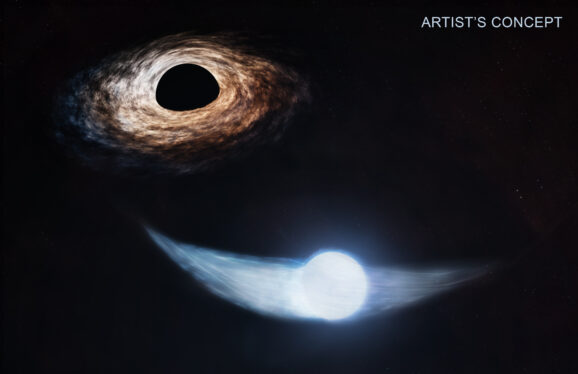By using new data from NASA’s Chandra X-ray Observatory and Neil Gehrels Swift Observatory as well as ESA’s XMM-Newton, a team of researchers have made important headway in understanding how — and when — a supermassive black hole obtains and then consumes material, as described in our latest press release.
This artist’s impression shows a star that has partially been disrupted by such a black hole in the system known as AT2018fyk. The supermassive black hole in AT2018fyk — with about 50 million times more mass than the sun — is in the center of a galaxy located about 860 million light-years from Earth.
Astronomers have determined that a star is on a highly elliptical orbit around the black hole in AT2018fyk so that its point of farthest approach from the black hole is much larger than its closest. During its closest approach, tidal forces from the black hole pull some material from the star, producing two tidal tails of “stellar debris”.
The illustration shows a point in the orbit soon after the star is partially destroyed, when the tidal tails are still in close proximity to the star. Later in the star’s orbit, the disrupted material returns to the black hole and loses energy, leading to a large increase in X-ray brightness occurring later in the orbit (not shown here). This process repeats each time the star returns to its point of closest approach, which is approximately every 3.5 years. The illustration depicts the star during its second orbit, and the disk of X-ray emitting gas around the black hole that is produced as a byproduct of the first tidal encounter.
Researchers took note of AT2018fyk in 2018 when the optical ground-based survey ASAS-SN detected that the system had become much brighter. After observing it with NASA’s NICER and Chandra, and XMM-Newton, researchers determined that the surge in brightness came from a “tidal disruption event,” or TDE, which signals that a star was completely torn apart and partially ingested after flying too close to a black hole. Chandra data of AT2018fyk is shown in the inset of an optical image of a wider field-of-view.
When material from the destroyed star approached close to the black hole, it got hotter and produced X-ray and ultraviolet (UV) light. These signals then faded, agreeing with the idea that nothing was left of the star for the black hole to digest.
However, about two years later, the X-ray and UV light from the galaxy got much brighter again. This meant, according to astronomers, that the star likely survived the initial gravitational grab by the black hole and then entered a highly elliptical orbit with the black hole. During its second close approach to the black hole, more material was pulled off and produced more X-ray and UV light.
Based on what they had learned about the star and its orbit, a team of astronomers predicted that the black hole’s second meal would end in August 2023 and applied for Chandra observing time to check. Chandra observations on August 14, 2023, indeed showed the telltale sign of the black hole feeding coming to an end with a sudden drop in X-rays. The researchers also obtained a better estimate of how long it takes the star to complete an orbit, and predicted future mealtimes for the black hole.
A paper describing these results appears in the August 14, 2024 issue of The Astrophysical Journal and is available online. The authors are Dheeraj Passam (Massachusetts Institute of Technology), Eric Coughlin (Syracuse University), Muryel Guolo (Johns Hopkins University), Thomas Wevers (Space Telescope Science Institute), Chris Nixon (University of Leeds, UK), Jason Hinkle (University of Hawaii at Manoa), and Ananaya Bandopadhyay (Syracuse).
NASA’s Marshall Space Flight Center manages the Chandra program. The Smithsonian Astrophysical Observatory’s Chandra X-ray Center controls science from Cambridge Massachusetts and flight operations from Burlington, Massachusetts.
Read more from NASA’s Chandra X-ray Observatory.
For more Chandra images, multimedia and related materials, visit:
https://www.nasa.gov/mission/chandra-x-ray-observatory/
Visual Description:
In this digital illustration, a star sheds stellar debris as it orbits a supermassive black hole. This artist’s impression represents the center of a galaxy about 860 million light-years from Earth.
The supermassive black hole sits at our upper left. It resembles an irregular, pitch-black sphere at the heart of an almond-shaped pocket of swirling sand and dirt. Though gritty in texture, the swirling brown and grey pocket is actually a disk of hot gas.
Near our lower right is the orbiting star. In this illustration, the star is relatively close to us, with the black hole far behind it. The star is a blue-white ball that, from this perspective, appears slightly larger than the distant black hole.
Two tapered streaks peel off of the glowing star like the pulled-back corners of a smile. These streaks represent tidal tails of stellar debris; material pulled from the surface of the star by the gravity of the black hole. This partial destruction of the star occurs every 3.5 years, when the star’s orbit brings it closest to the supermassive black hole.
During the orbit, the stellar debris from the tidal tails is ingested by the black hole. A byproduct of this digestion is the X-ray gas which swirls in a disk around the black hole.
At the upper left of the grid is an image of the distant galaxy cluster known as MACS J0416. Here, the blackness of space is packed with glowing dots and tiny shapes, in whites, purples, oranges, golds, and reds, each a distinct galaxy. Upon close inspection (and with a great deal of zooming in!) the spiraling arms of some of the seemingly tiny galaxies are revealed in this highly detailed image. Gently arched across the middle of the frame is a soft band of purple; a reservoir of superheated gas detected by Chandra.
News Media Contact
Megan Watzke
Chandra X-ray Center
Cambridge, Mass.
617-496-7998
Lane Figueroa
Marshall Space Flight Center
Huntsville, Ala.
256-544-0034
https://www.nasa.gov/image-article/nasa-telescopes-work-out-black-holes-snack-schedule/







